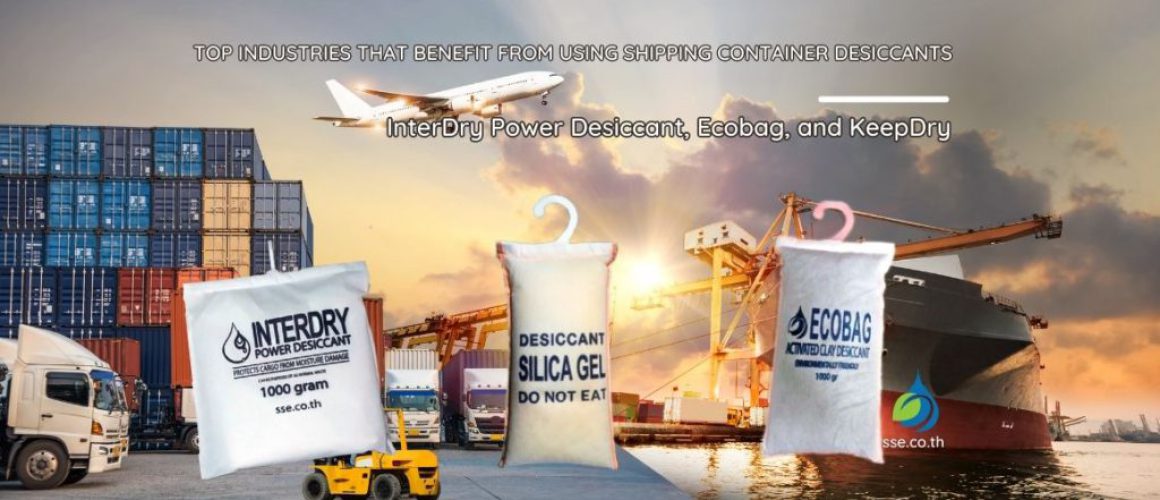Top Industries That Benefit from Using Shipping Container Desiccants
Industries That Rely on Desiccants
| Industry | Common Goods Shipped | Moisture Risk |
|---|---|---|
| Electronics | Circuit boards, consumer devices | Corrosion, short-circuit |
| Pharmaceuticals | Medicines, medical equipment | Spoilage, contamination |
| Food | Packaged goods, dried foods | Mold, spoilage |
| Textiles | Clothing, fabrics | Mold, mildew |
| Machinery | Tools, engines, metal components | Rust, corrosion |
Table of Contents
I. Introduction
Shipping container desiccants play a crucial role in protecting cargo from moisture damage across various industries. By controlling humidity and preventing condensation, these desiccants ensure that goods reach their destination in pristine condition. In this article, we will explore the wide range of industries that benefit from using shipping container desiccants like InterDry Power Desiccant, Ecobag, and KeepDry.

II. Agriculture Industry
A. Crop Protection
Shipping container desiccants help preserve the quality and freshness of agricultural products like coffee, tea, cocoa, fruits, and vegetables during transportation. By maintaining optimal humidity levels inside the container, desiccants prevent the growth of mold and mildew, ensuring that the products arrive at their destination in the best possible condition.
B. Seed Preservation
Desiccants play a vital role in seed preservation by controlling humidity within the container. This helps maintain the viability of seeds by preventing the growth of mold, mildew, and other damaging fungi. As a result, farmers and growers can rest assured that their seeds will remain viable and ready for planting upon arrival.
Moisture-Related Challenges for Each Industry
| Industry | Moisture-Related Challenge | Desiccant Solution |
|---|---|---|
| Electronics | Corrosion of circuits | High-absorption silica gel |
| Pharmaceuticals | Contamination of medicines | Low-dust, food-grade desiccants |
| Food | Spoilage, bacterial growth | Calcium chloride for high moisture |
| Textiles | Mold growth | Clay desiccants for gentle drying |
| Machinery | Rust and degradation of parts | Large-capacity desiccants |
III. Wood and Paper Products Industry
A. Timber and Wood Preservation
Shipping container desiccants protect wood and timber from warping, mold, and mildew during transport. By regulating humidity levels within the container, desiccants help maintain the structural integrity of wood products such as furniture, moldings, and wooden crates. This is essential for industries that rely on the quality of their wood products for successful business operations.
B. Paper and Cardboard Preservation
Using desiccants in shipping containers ensures that paper products like books, magazines, and cardboard packaging materials remain dry and free from moisture damage. Excess humidity can cause paper to become discolored, warped, or develop mold, which can compromise the quality of the products. Desiccants help maintain the quality and appearance of paper goods during transport, ensuring they arrive in the best condition possible.

IV. Textile and Apparel Industry
A. Fabric and Garment Protection
Shipping container desiccants prevent the growth of mold and mildew on textiles and garments during transportation. By maintaining optimal humidity levels within the container, desiccants help preserve the color, texture, and quality of fabrics, ensuring that garments and textiles arrive at their destination in excellent condition.
B. Leather Goods Preservation
Shipping container desiccants safeguard leather goods like footwear, garments, and furniture from humidity damage and discoloration. Excess moisture can cause leather to become discolored, stiff, and prone to cracking. By controlling humidity levels, desiccants help maintain the quality and appearance of leather products during transport.
Common Desiccants Used by Industry
| Industry | Primary Desiccant Used | Reason for Use |
|---|---|---|
| Electronics | Silica Gel | Moderate moisture absorption |
| Pharmaceuticals | Food-Grade Silica Gel | Non-toxic, safe for consumables |
| Food | Calcium Chloride | High absorption, prevents spoilage |
| Textiles | Activated Clay | Affordable, moderate absorption |
| Machinery | Calcium Chloride | High capacity, prevents corrosion |
V. Electronics and Electrical Goods Industry
A. Corrosion Prevention
Shipping container desiccants protect electronic devices and components from moisture-induced corrosion and malfunction. High humidity levels can cause oxidation and short-circuiting in electronic devices, leading to product failure. By maintaining a dry environment within the shipping container, desiccants help ensure that electronic goods arrive in working condition.
B. Packaging and Storage Preservation
Using desiccants in shipping containers helps maintain the integrity of packaging materials and the performance of electronic goods. This is especially important for sensitive electronic equipment, such as computers, medical devices, and communication systems. Desiccants help protect these valuable items from the damaging effects of moisture during transportation and storage.
VI. Pharmaceutical and Healthcare Industry
A. Medicine and Drug Preservation
Shipping container desiccants are essential in maintaining the efficacy of medications and medical devices during transport. Excess moisture can compromise the quality and potency of pharmaceutical products, potentially rendering them ineffective or even harmful. By controlling humidity levels within the container, desiccants help ensure that medical supplies arrive at their destination in optimal condition.
B. Diagnostic Equipment Protection
Shipping container desiccants play a crucial role in protecting delicate diagnostic equipment, such as imaging devices and laboratory instruments, from moisture damage during transportation. These devices are often sensitive to changes in humidity, which can affect their performance and accuracy. Desiccants help maintain a stable environment within the shipping container, ensuring that diagnostic equipment remains in perfect working condition upon arrival.
C. Medical Rubber Gloves
The healthcare industry, which includes the production and export of medical rubber gloves, greatly benefits from shipping container desiccants, as they help maintain the quality and sterility of these essential products during transportation to Europe, the US, and other global destinations
Shipping Container Desiccants: Cost vs. Effectiveness
| Desiccant Type | Cost | Absorption Capacity | Best Use Case |
|---|---|---|---|
| Silica Gel | Moderate | Moderate | Electronics, pharmaceuticals |
| Calcium Chloride | Higher | High | Food, machinery |
| Clay Desiccants | Low | Moderate | Textiles, short-term shipments |
VII. Metal and Machinery Industry
A. Rust Prevention
Shipping container desiccants help prevent rust and corrosion on metal parts, machinery, and equipment during transport. Excess moisture can cause metal surfaces to oxidize, leading to rust and reduced structural integrity. By controlling humidity levels within the shipping container, desiccants help protect valuable machinery and metal components from moisture damage.
B. Lubricant and Sealant Preservation
Shipping container desiccants also help maintain the effectiveness of lubricants and sealants used in machinery and equipment. Excess humidity can cause these products to break down or become less effective, potentially leading to mechanical failure. By using desiccants during transport, industries can ensure that their machinery and equipment remain in optimal working condition.
Key Moisture Risks by Geographic Region
| Region | Climate | Primary Moisture Risk | Desiccant Recommendation |
|---|---|---|---|
| Southeast Asia | High humidity, tropical | Mold, container rain | Calcium chloride, high absorption |
| North America | Mixed climates, temperate | Seasonal condensation | Silica gel, moderate absorption |
| Middle East | Dry, arid | Sudden humidity changes | Clay desiccants, cost-effective |
VIII. Automotive and Aviation Industry
A. Spare Parts Protection
Shipping container desiccants are essential in protecting automotive and aviation spare parts from moisture damage during transport. High humidity levels can cause rust and corrosion on metal parts, while excess moisture can lead to the degradation of rubber components, such as seals and gaskets. Desiccants help maintain the quality and longevity of spare parts, ensuring that they are ready for use upon arrival.
B. Vehicle and Aircraft Preservation
Desiccants are used to protect entire vehicles and aircraft during transportation and storage. By controlling humidity levels within the shipping container, desiccants help prevent corrosion, rust, and moisture-related damage to vehicles and aircraft, ensuring they remain in excellent condition.
IX. Art and Antiques Industry
A. Artwork Preservation
Desiccants help protect valuable artwork and antiques from moisture damage during transportation. Paintings, sculptures, and other delicate artifacts are susceptible to humidity-related issues, such as mold, mildew, and warping. Desiccants help maintain the right environmental conditions within the shipping container, ensuring that valuable art pieces arrive at their destination in perfect condition.
B. Antique Furniture Protection
Shipping container desiccants also play a crucial role in preserving antique furniture during transport. Excess moisture can cause wooden furniture to warp, crack, or develop mold, compromising the value and integrity of the piece. By controlling humidity levels within the container, desiccants help protect antique furniture from moisture damage.
X. Shipping Container Desiccants, Keeping your Products Safe
In conclusion, shipping container desiccants play a critical role in safeguarding cargo across a wide range of industries. By controlling humidity levels and preventing moisture-related damage, products like InterDry Power Desiccant, Ecobag, and KeepDry help ensure that goods arrive at their destination in optimal condition. As a result, businesses can maintain the quality and value of their products, ultimately contributing to their success and growth.
XI Frequently Asked Questions
How does InterDry Power Desiccants help solve moisture problems?
Shipping container desiccants absorb moisture by extracting water vapor present in the air, thus preventing the humidity inside the container from reaching dew point and condensing. The desiccant then starts to turn into a gel as it continues to absorb moisture. The water absorbed is retained due to the presence of a special binding agent, thus preventing it from leaking. Lower relative humidity InterDry controls the humidity inside containers by preventing the air from reaching dew point and condensing, thus protecting your precious cargo.
What is Relative Humidity (RH)?
Relative humidity measures the amount of moisture in the air. It is expressed in a percentage of how much moisture the air could possibly hold. The wetter or damper the air is, the higher the relative humidity. The drier the air feels, the lower the relative humidity.
What are the most common problems caused by moisture?
Moisture in shipping containers causes problems such as mold, fungus, mildew, rust decay, lumping, caking, agglomeration, and decomposition. Moisture can also cause electronics to malfunction.
Is moisture damage always instantly visible when handling the cargo?
Unfortunately moisture damage is not always instantly visible when handling the cargo. Though common forms of moisture problems such as corrosion, mold, or fungus are visible on the cartons, surfaces etc. there are some kinds of damages that are not visible. Mostly these damages are internal and visible only when the customer opens the shipments. In the case of devices, they often cease to function the way they should
I fumigate my containers; do I still need to put in desiccants?
Fumigation and using desiccants have two different purposes and are not alternatives to protect your goods against moisture damage. Fumigation is primarily to eliminate insects and eggs in the container and in the goods. It has no influence on the humidity inside a container. Desiccants will not influence the effects of fumigation and can easily be put in before or after fumigation.
If I use InterDry Power Desiccant, will I have any more moisture problems?
InterDry Power Desiccant prevents moisture damage by controlling the Relative humidity and prevents moisture problems. However, the ventilation holes in the container need to be closed and the number of units of Shipping container desiccants to be put in a container needs to be adjusted to the situation.
I load my container under dry conditions and it is tightly sealed. Why are there moisture problems?
If there are still moisture problems, we can easily say that the number of units per containers currently is not sufficient and it is advisable to increase the units per container. There are many factors for bigger amounts of moisture inside the container. Examples of those factors are:
Container Floor: Recent studies carried out by R&D department, proved that the moisture content of the wooden floors is higher than they used to be. That is partly because of the quality of the wood that is being used nowadays and partly because the floors are being cleaned with water and they are not dried out enough before being used.
Packaging: Wooden pallets always contain more than 20 % moisture, which always causes problems whichever products are put on the pallets. The packaging, often being cartons, contains a lot of moisture in itself, which will spread into the cargo or vaporizes into the air.
Products: The biggest factor of moisture inside a container is the products itself. The MC varies roughly spoken between 10% and 35%. When the MC reach the 25%, the cargo is in the danger zone.
Journey and climate factors: When all the above mentioned factors are controlled and there is still a problem, they surely are the conditions during transport. The first point of consideration is the transport time. It depends on the destination and more importantly the climate during shipment and final destination. Basically, the changes in temperature and automatically the relative humidity is the cause of condensation. If long transits cannot be avoided, again our advice is to add more units to absorb the extra water molecules.
I ship consumer goods in tubes/cans/jars etc. that contain no moisture, yet I still have problems.
The moisture comes from the container floor, pallets, open ventilations, weather change during journey. And it will condense on the tubes/cans/jars that cause corrosion and labels to fall off.
Each container of my cargo of peanuts/coffee/cocoa contains tons of moisture. What difference does it make if InterDry absorbs a few liters moisture during a voyage?
InterDry Power Desiccant absorbs the excess water molecules in the air and reduces the Relative Humidity inside the container, so that it will not reach the dew point.
Does it make a lot of difference that my cocoa beans have a moisture content of 8% instead of 7%?
One percent more or less doesn’t make a difference, especially not when the MC is on the lower side.
My cargo of peanuts suffered damage in the center even though the outside of the cargo looked fine and there were no signs of condensation. Why?
Condensation on the surface of your cargos can evaporate quickly, but it takes more time for the moisture which gets trapped deeper. Before it evaporates back to the air, mold and fungus would have already grown.
How does Silica gel works?
Silica gel is the most common type of desiccant in use today. It is porous sand and can absorb moisture in the air. However, silica gel absorbs moisture best in small, confined spaces and often ends up getting saturated in a very short time span, making them unsuitable for long range container shipments. Beware that some silica gel – the blue contains cobalt – is not environmentally friendly, and cannot be disposed of any which way.
Do I still need to use silica gel in my boxes?
It is definitely not a bad idea to use sachets of silica where the air is tight, and moisture is trapped, like in boxes and items packed in plastics.
My cargo was damaged even though I used a lot of silica gel and there was no condensation. Would it help to switch to InterDry?
Perhaps there was not enough Silica Gel put inside the container. You need about 40Kg Silica Gel for a 20″ container. I can assure you a better result with InterDry Power Desiccants. Silica works pretty well in smaller closed spaces, like shoeboxes. It absorbs very quickly and is often already saturated before the container is moved.
What is so great about InterDry anyway?
We have superb products that actually reduce the RH inside the container. When it absorbs moisture, the powder base will change into a gel. It is more efficient and safe in use. Even when the product gets damaged, it will not spill any water on the goods. It is easy, safe, and inexpensive solution for the problems with moisture damage.
How many units of container desiccant must be put in one container?
That depends on many things. The container size, the cargo, moisture of cargo, moisture of container’s floor, moisture of pallets, length of journey, and weather during journey and so on. An example: a 20 feet container with KD (Kiln Dried) furniture needs 4-6 units, while 20″ air dried furniture needs 6-8 units. We generally offer expert advice regarding optimum usage of the desiccants for best results.
Do I need to line my container with Kraft paper?
Kraft paper is a commonly used method of containing “rainfall” that occurs inside a container. Normally it is installed under the ceiling to absorb the moisture that may occur due to container rain. It is most useful while shipping goods that have very high moisture condensation, but it cannot replace a desiccant that soaks up the humidity before it even turns into rain.
My containers are stuffed till the top. Can InterDry still be useful?
It seems that there is almost no free air in the container, while there is actually a lot of free air between the products, and InterDry absorbs the moisture in that air and prevents condensation.
I have problems with mold growth inside my shrink-wrapped pallets. Will InterDry help?
No, unless you make holes so the water molecules won’t get trapped.
My shipment of steel/galvanized components, aluminum, machinery etc. arrives corroded, stained or discolored, despite heavy packaging. Will InterDry help?
Yes, as long as you put enough units per containers and do not wrap the items in plastic.
Can I re-use my InterDry Power Desiccants?
InterDry Power Desiccants are one-time usable, environmentally friendly and disposable as normal waste.
My cargoes are outdoor furniture with brass parts on it. When the goods arrive at the destination, the wooden part is in perfect condition but the brass part has slight stains on it. What should I do to avoid this?
I suggest adding one or two more units and wrapping it properly with only single face carton.
7 Tips for Maximizing the Efficiency of Your Shipping Container Desiccants
https://www.sciencedirect.com/topics/medicine-and-dentistry/desiccant
https://www.sciencedirect.com/science/article/pii/S2666154322002113
